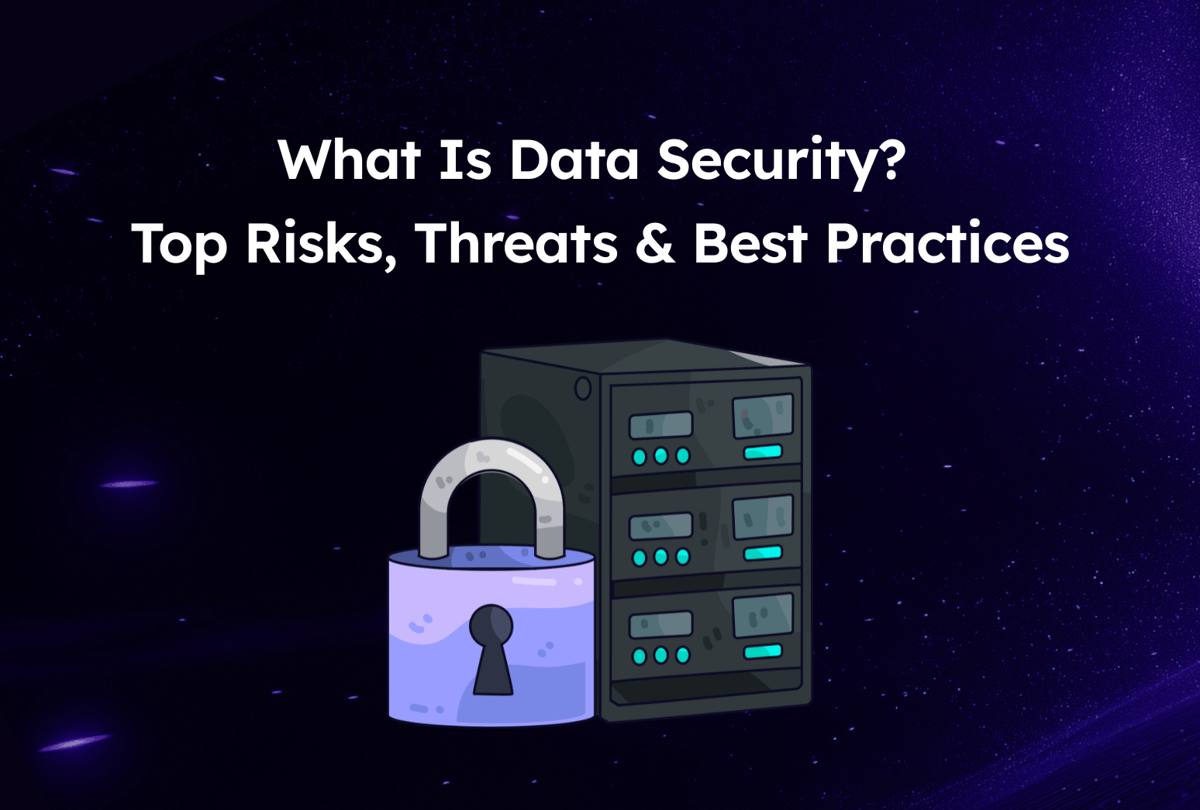What is data security?
Data security is the discipline of defending digital assets, files, databases, and platforms from unauthorized access, corruption, or theft. It’s about control: knowing where your data lives, who can access it, and how it’s protected. At its core, data security is about preserving trust by protecting the confidentiality, integrity, and availability of your most critical data at all times. It's a strategy to keep sensitive information locked down, whether it’s sitting in storage, moving across networks, or powering live operations. As organizations collect and process more personal, financial, and mission-critical data than ever before, the pressure is on. Threats are everywhere: cyberattacks, insider risks, accidental leaks, and compliance gaps are all part of the landscape.
This guide shows how to understand your top risks and build a defense that’s agile, layered, and always-on.
What are the different types of data security?
Data security isn’t one-size-fits-all. To be effective, it must be a layered defense built from smart, interconnected measures. Consequently, data security can be categorized into several types depending on its use case and sensitivity, such as these typical classifications:
- Conceptual pillars: confidentiality (encryption, access control), integrity (hashing, digital signatures), and availability (backups, redundancy).
- By data state: data at rest, data in transit, data in use.
- Security by classification level: public, internal (non-public business), confidential/sensitive, highly restricted/regulated
- Core technical types: Identity and access management (IAM); Network and transport security; encryption and key management; privacy/data obfuscation (cryptography, tokenization, data masking, anonymization); data loss prevention (DLP); and others (endpoint, application, database, and device security).
- Cloud and SaaS data security: CSPM/SSPM posture management, least‑privilege cloud IAM, data residency, customer‑managed keys, storage bucket policies, and shared responsibility model.
- Operational data security: Data governance and lifecycle; classification policy, data catalog/lineage, ownership, quality, stewardship, acceptable use.
However, this article will focus on cloud and SaaS data security.
Therefore, below is a comprehensive, step-by-step blueprint for safeguarding data in the cloud and SaaS environments, engineered to empower you with clear strategies for designing, deploying, and managing robust controls across IaaS, PaaS, and SaaS platforms:
Core principles
- Shared responsibility: The provider secures the cloud; conversely, you secure what you put in it (configs, identities, data, endpoints).
- Zero Trust: Verify explicitly (strong identity), use least privilege, assume breach, monitor continuously.
- Data lifecycle focus: Know where data is created, stored, processed, shared, and destroyed.
SaaS‑specific data controls
- Tenant and sharing policies: External sharing restrictions, domain allow/deny lists, link expiry, viewer‑only modes.
- Data loss prevention (DLP): Inline and API‑based DLP for email, chat, storage, and docs; real‑time and retro scans.
- Information rights management (IRM/DRM): Prevent download/print/copy; watermarking; label‑based protections.
- Data residency/localization: Choose regions/tenants; restrict cross‑border transfers; understand subprocessors.
- Retention/legal hold: Granular retention schedules, legal holds, defensible deletion.
- Unmanaged devices: Conditional access, web‑only mode, block downloads to unmanaged endpoints.
Cloud (IaaS/PaaS) data controls
- Storage security: Bucket/container policies, block public access by default, object versioning, and Object Lock/immutability.
- Database security: Row/column/label security, TDE, customer‑managed keys, DB activity monitoring.
- Secrets management: Managed secrets stores; prevent hard‑coded secrets; rotate and scope tightly.
- Compute security: Hardened images, patching, confidential VMs/TEEs for data‑in‑use protection.
- Container/Kubernetes: Namespaces, network policies, image signing/scanning, secrets as references, data encryption.
This is how modern organizations keep their data locked down and resilient. Layer up, stay informed, and keep your data where it belongs.
What's the difference between data security and data privacy?
Data security and data privacy are two sides of the same coin, but they solve different problems.
Data security is your shield and armor. It’s all about the tools, tech, and tactics you deploy to keep sensitive information locked down: protected from hackers, breaches, corruption, or accidental loss. Think firewalls, encryption, access controls, and constant vigilance. Security is the fortress that keeps the bad actors out and your data safe inside.
Data privacy is the code you live by; it’s about using data responsibly. It’s about how you collect, use, and share information: making sure you treat people’s data with respect, transparency, and in line with the law. Privacy is about giving individuals control over their own information and ensuring it’s only accessed for the right reasons, by the right people, at the right time.
In short:
- Security is the “how”, the technical muscle that protects your data.
- Privacy is the “why”, the ethical and legal compass that guides how you handle it.
Security keeps data out of the wrong hands. You can’t have true privacy without strong security, and security alone means nothing if you’re not handling data responsibly. Together, they build trust and keep your digital world in balance.
What are the top risks and threats to data security?
What are the real threats to your data? The ones already inside, the ones hiding in plain sight, and the ones that never sleep.
Here’s a breakdown of the top risks that compromise data security, each one a potential entry point for disruption, data loss, or worse:
- Insider threats: Not all risks wear a mask. Whether it’s a careless mistake or a malicious act, employees and contractors can expose sensitive data, often without realizing it.
- Phishing attacks: The classic “bait-and-breach.” Threat actors pose as trusted sources to trick users into giving up credentials, access, or sensitive information. It’s simple and still devastatingly effective.
- Malware: From spyware to trojans, malicious code is engineered to infiltrate systems, exfiltrate data, and compromise operations, quietly or with chaos.
- Ransomware: Encrypts your data. Locks you out. Demands payment. These attacks are fast, costly, and increasingly automated.
- Weak passwords: Simple, reused, or default credentials remain one of the easiest ways in for attackers and one of the most preventable.
- Unpatched software: Every missed update is an open door. Outdated systems are low-hanging fruit for attackers exploiting known vulnerabilities.
- Social engineering: Humans are often the weakest link. Manipulative tactics bypass technical defenses by exploiting trust, urgency, or fear, thereby undermining the security of systems.
- Cloud misconfigurations: As workloads shift to the cloud, misconfigured storage, excessive privileges, or a lack of visibility can expose critical data, sometimes publicly.
- Physical theft or loss: Stolen laptops, misplaced USBs, and unsecured endpoints can quickly become security incidents if not properly encrypted and tracked.
- Advanced persistent threats (APTs): These aren’t smash-and-grab attacks. APTs infiltrate quietly, move laterally, and harvest data over weeks or months, often unnoticed.
¹Gartner’s “Top Cybersecurity Trends for 2025 reflects the need for more focused cybersecurity programs that emphasize business continuity and collaborative risk management.” Furthermore, it spotlights a threat landscape that’s more dynamic and demanding than ever:
- GenAI on the rise: Generative AI isn’t just powering new innovations; it’s also fueling fresh attack vectors and risks that security teams are still racing to understand.
- Security talent burnout: The gap between cybersecurity talent and demand keeps widening, leaving teams stretched thin and burnout on the rise.
- Cloud everywhere: Cloud adoption shows no signs of slowing down, reshaping digital ecosystems and multiplying the surfaces attackers can target.
- Regulation ramps up: Governments are tightening the screws on cybersecurity, privacy, and data localization, meaning more rules, more oversight, and higher stakes for SaaS compliance.
- Decentralized digital power: Digital capabilities are spreading out across the enterprise, making it harder than ever to keep tabs on assets, identities, and risks.
Defense starts with awareness. Mitigating these threats means training people, hardening systems, enforcing least privilege, and closing the gaps in real-time. Because in the world of data security, every weakness is an opportunity, and attackers only need one.
What are the main data security regulations and compliance requirements?
When it comes to data security, compliance isn’t optional. It’s the rulebook for protecting sensitive information and earning customer trust. Here’s a breakdown of the heavy hitters every organization needs to know:
General Data Protection Regulation (GDPR): The gold standard for privacy in the EU. GDPR demands transparency, fairness, and strict limits on how personal data is collected, used, and shared. It’s all about giving individuals control and holding organizations accountable for every byte they handle.
California Consumer Privacy Act (CCPA): California raised the bar for consumer rights. CCPA gives residents the power to know what data is collected, request its deletion, opt out of its sale, and shields them from discrimination for exercising those rights.
Health Insurance Portability and Accountability Act (HIPAA): The backbone of healthcare data protection in the U.S., HIPAA sets the rules for how providers, insurers, and their partners safeguard patient health information and mandates that privacy and security are non-negotiable.
Payment Card Industry Data Security Standard (PCI-DSS): If you handle credit or debit card data, PCI-DSS is your playbook. This global standard lays out exactly how to secure payment information and keep financial transactions safe from fraud.
Family Educational Rights and Privacy Act (FERPA): U.S. schools and colleges follow FERPA to keep student records private and give families control over educational information.
Federal Information Security Management Act (FISMA): Federal agencies and contractors in the U.S. must follow FISMA, which requires rigorous information security programs and risk management for government data.
Sarbanes-Oxley Act (SOX): Public companies in the U.S. rely on SOX to set the standard for storing, securing, and reporting financial records, and data integrity is everything.
Personal Data Protection Act (PDPA): Singapore’s answer to data privacy, PDPA spells out how organizations must collect, use, and protect personal data.
Personal Information Protection and Electronic Documents Act (PIPEDA): Canada’s federal law for commercial data, PIPEDA requires businesses to safeguard personal information and respect consumer rights.
The Australian Privacy Act, including the Australian Privacy Principles: This legislation establishes the baseline for how government agencies and many private organizations in Australia manage and protect personal information.
No matter where you operate, these regulations demand more than just good intentions. They require real security controls, regular audits, and a culture of accountability. Staying compliant means avoiding fines and showing customers and partners that you take data protection seriously, thus maintaining trust.
The best practices, techniques, and solutions for data security
Data security isn’t a single solution, but a system of layered defenses, proactive policies, and continuous awareness. Here’s what that looks like in practice:
Best practices that matter
These are some of the best practices for data security:
- Lock down access: Enforce strong authentication; think complex passwords, MFA, biometric checks, and least-privilege access models. No one gets in unless they are supposed to.
- Train relentlessly: Your people are part of your perimeter. Equip them to recognize phishing attempts, social engineering tactics, and data handling risks. Make security second nature.
- Encrypt everything: Whether data is at rest or in transit, encryption is non-negotiable. It’s the last line of defense when other controls fail.
- Back up like it’s inevitable: Ransomware. Hardware failure. Insider sabotage. Regular, secured backups ensure that recovery is an option, not a desperate hope.
- Update without delay: Every unpatched vulnerability is a countdown to compromise. Patch aggressively, update frequently, and automate where possible.
Techniques that raise the bar
Data protection requires both policy and precision. Defending sensitive information demands a blend of smart techniques and resilient tools that work together to reduce risk, limit exposure, and strengthen your security posture across the board.
- Data anonymization: Strip out the identifiers. This method makes data sets functionally useful but useless to attackers, removing the personal information, keeping the value.
- Data masking: Obfuscate the real thing. Replace sensitive values with dummy data in non-production environments to protect while you test.
- Intrusion detection systems (IDS): Your early warning system. IDS tools detect and flag suspicious behavior before it turns into an incident.
- Penetration testing: Think like an attacker. Simulated attacks help uncover weak points, so you can fix them before someone else finds them first.
Solutions that lock it down
- Endpoint security management: Every device is a potential entry point. Therefore, secure laptops, mobile devices, and remote endpoints, especially in cloud-first, hybrid environments.
- Firewall: Still essential. A strong firewall filters out unauthorized access attempts and keeps your perimeter tight.
- Anti-malware and antivirus software: Your last line of defense against code-level attacks is detecting and removing threats in real time.
- Virtual private network (VPN): VPN encrypts the route, creating secure, private tunnels for data transmission, especially critical in remote or public network scenarios.
- Data loss prevention (DLP) tools: Monitor, flag, and stop sensitive data from leaving your ecosystem, whether by accident or intent.
- Security information and event management (SIEM) software: Centralized visibility and management. SIEM aggregates logs across your stack to identify abnormal patterns fast and give your team the signal intelligence it needs to act.
No single method solves security. It's the orchestration, the act of layering tools, enforcing practices, and staying adaptive, that keeps your data secure. At Vorlon, that’s the standard we build toward: intelligent, context-aware defense that evolves as fast as your attack surface.
How do SaaS ecosystems struggle with data security?
SaaS ecosystems promise speed and flexibility, but when it comes to data security, they’re a minefield of hidden risks and blind spots.
Therefore, SaaS ecosystems can experience data security struggles in several ways:
Lack of visibility and control
With SaaS, your data lives on someone else’s infrastructure. While the cloud offers benefits, ²Gartner points out that as “organizations use the cloud or share their data with third parties, they lose direct control of typical perimeter and physical protections.”
That means you’re often struggling to see where your sensitive information resides, who’s accessing it, and how it’s being protected. This lack of transparency makes it tough to enforce security policies or spot suspicious activity before it’s too late.
This shortcoming, according to ³Gartner, has crystallized “the need for a data-centric view of security.”
Multitenancy: Shared walls, shared risks
SaaS runs on a multitenant architecture, where multiple customers (tenants) share the same software environment. If security boundaries aren’t rock-solid, there’s a risk that one tenant’s data could bleed into another’s, exposing sensitive information to the wrong eyes
Data in motion, frequently exposed
Every time data moves between your users and the SaaS provider, there’s a chance for interception or leakage. Without robust encryption and monitoring, sensitive information can easily slip through the cracks.
Access management: Too many doors, not enough locks
With dozens (or hundreds) of SaaS apps, access control quickly becomes chaos. Weak passwords, inconsistent authentication, and orphaned accounts open the door to unauthorized access and insider threats.
Third-party and integration risks
SaaS thrives on integrations, but every connected app is a new attack surface. If a third-party tool isn’t secure, it can become the backdoor cybercriminals use to reach your data.
Misconfiguration: One wrong setting, enormous consequences
SaaS platforms are complex, and a single misconfigured setting can expose massive amounts of data. Default security settings often aren’t enough; therefore, continuous audits and tight configuration management are a must.
Compliance headaches are a moving target
With data crossing borders and regulations shifting constantly, staying compliant is a never-ending challenge. SaaS providers might not meet your industry’s requirements, and proving compliance can be nearly impossible without the right audit trails and controls.
Data ownership and location. Who holds the keys?
When contracts end or providers change, questions about who owns the data and where it’s stored become critical. Legal risks mount if you can’t guarantee data sovereignty or secure deletion on demand.
The bottom line
SaaS security is less about trusting your provider and more about building layered defenses, demanding transparency, and staying proactive. That means strong encryption, multi-factor authentication, rigorous access controls, regular security audits, and a relentless focus on compliance. In the SaaS world, security is never set-and-forget but rather a continuous journey.
How does Vorlon help enterprise SaaS with data security?
Vorlon gives enterprise SaaS teams the visibility they’ve been missing and the control they didn’t know they could have.
We don’t just monitor SaaS environments. We model them. Vorlon builds a real-time, dynamic map of how data moves across users, apps, and integrations, revealing previously unseen misconfigurations and risky behaviors, before they become breaches.
From unusual access patterns to permissions that quietly sprawl, Vorlon quickly surfaces what matters most. Our automated compliance checks and integration-level audits ensure your environment stays aligned with both regulatory demands and internal policies, without slowing down business operations.
With Vorlon you don’t just react to threats; you see them coming. Secure your SaaS ecosystem with precision, confidence, and clarity.
¹ Cybersecurity Trends: Resilience Through Transformation, 2025. GARTNER is a registered trademark and service mark of Gartner, Inc. and/or its affiliates in the U.S. and internationally and is used herein with permission. All rights reserved.
² Gartner Research: Guide to Data Security Concepts, 11 January 2024. GARTNER is a registered trademark and service mark of Gartner, Inc. and/or its affiliates in the U.S. and internationally and is used herein with permission. All rights reserved.
³ Gartner Research: Guide to Data Security Concepts, 11 January 2024. GARTNER is a registered trademark and service mark of Gartner, Inc. and/or its affiliates in the U.S. and internationally and is used herein with permission. All rights reserved.







.png?width=400&height=300&name=Updated%20Blog%20Featured%20Image%20Template%20(1).png)



